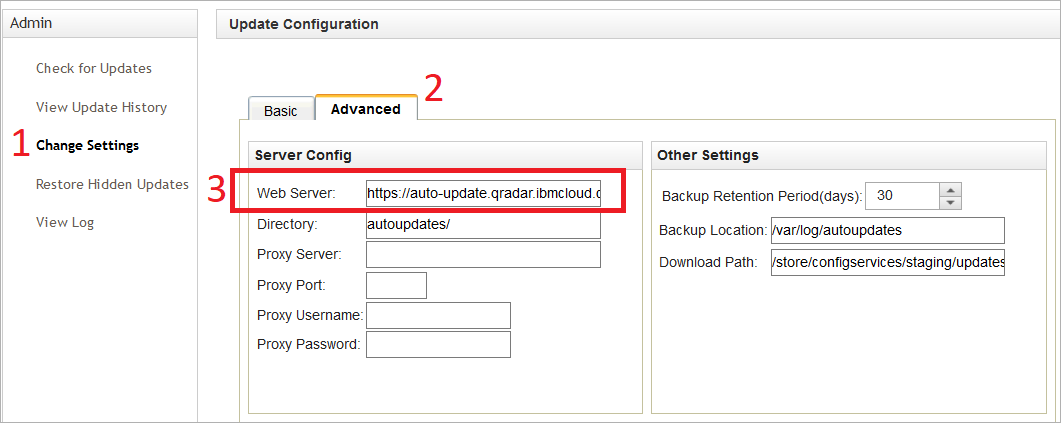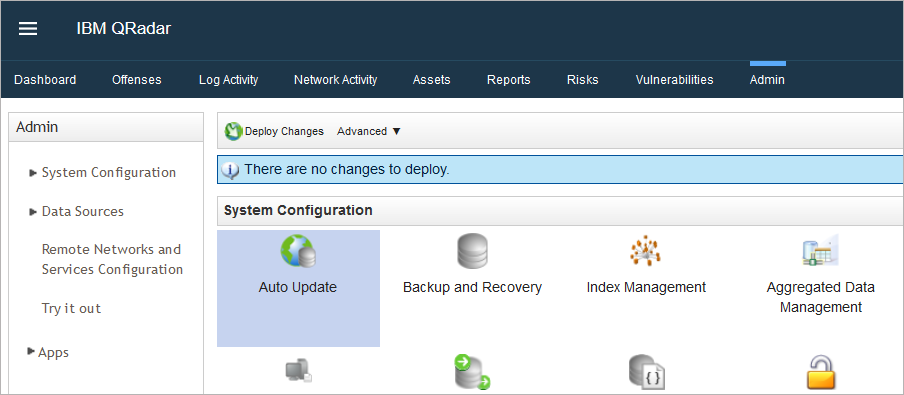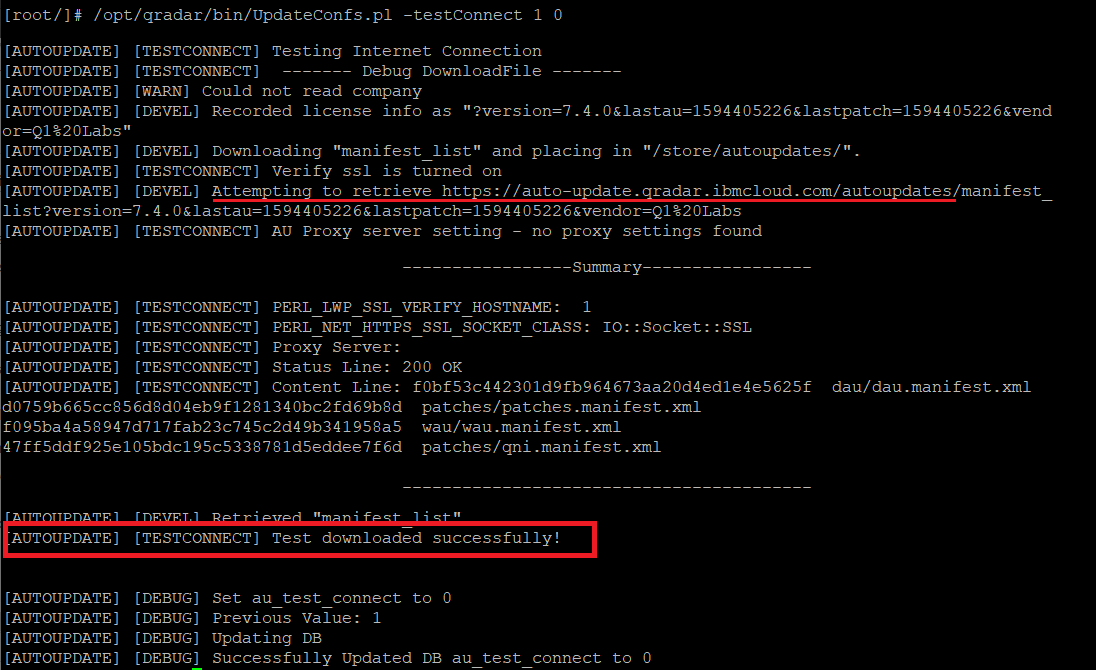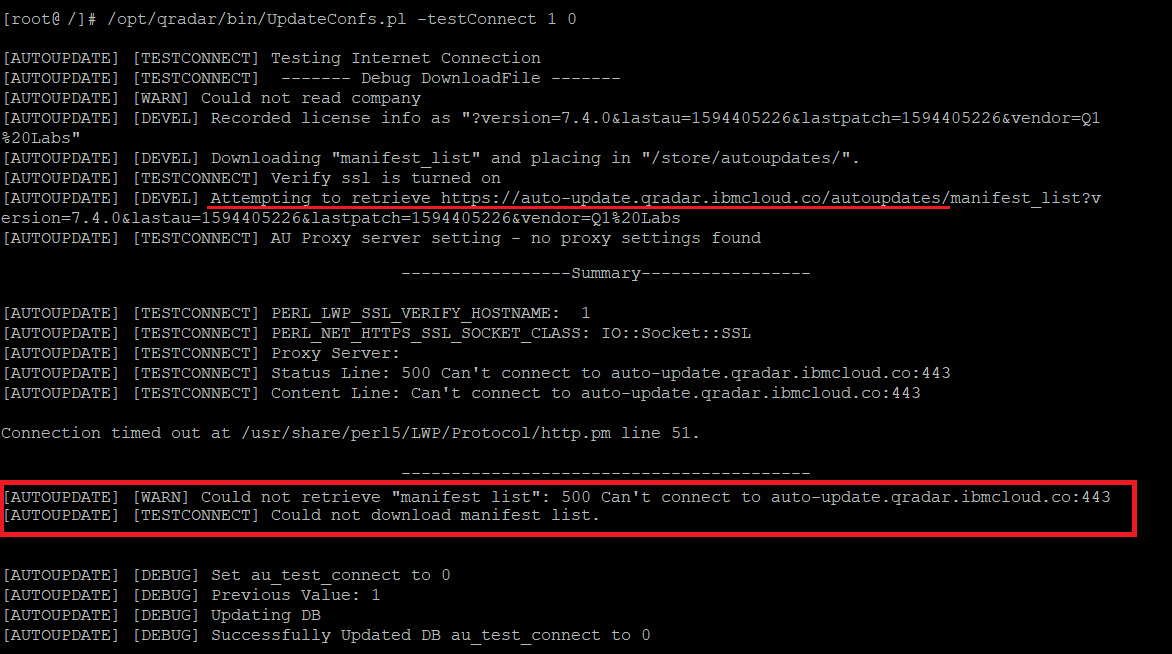Troubleshooting
Problem
Resolving The Problem
About
| Server changes | Web server hostname | Static IP address and port | Location | Description |
| New server cluster | https://auto-update.qradar.ibmcloud.com/ | 169.47.251.244:443 | Global | New server active on 27 July 2020 |
| Legacy server | https://qmmunity.q1labs.com/ | 69.20.113.167 | United States | Active until 30 November 2020 |
| Legacy server | https://qmmunity-eu.q1labs.com/ | 212.64.156.13 | Europe | Active until 30 November 2020 |
Affected versions
IMPORTANT: Administrators who fail to update their corporate firewalls might experience an interruption in service after 30 November 2020. QRadar® Support recommends that all administrators update their QRadar Console's auto update settings during a maintenance window and confirm that auto updates complete successfully.
Summary
| Web server | Static IP address and port | Location | Description |
| https://auto-update.qradar.ibmcloud.com/ | 169.47.251.244:443 | Global | New server active on 27 July 2020 |
Action Required: Configuring your auto update server address
All QRadar administrators are expected to update their auto update server configuration by 30 November 2020 to prevent an interruption in auto update downloads.
- Log in to the QRadar Console as an administrator.
Notice: QRadar on Cloud administrators are not required to make this change. The QRadar on Cloud DevOps team implemented a change on QRadar on Cloud Console appliances to use the new IBM Cloud weekly auto update server. - Click the Admin tab.
- Click Change Settings.
- Click the Advanced tab to configure the update server and backup settings.
- In the Web Server field, type the following address: https://auto-update.qradar.ibmcloud.com/

Note: The Web Server field must include a trailing forward slash '/' character to prevent Invalid format for server errors. If you receive an invalid format error message, verify your auto update server URL ends with a forward-slash.
- If prompted, click Yes to load the auto update settings. This service restart does not stop any services, only reloads the configuration and refreshes the existing configuration.
- To test the auto update configuration, click Check for Updates.
- Click Get New Updates.

- Wait for the auto update server to update files.

Results
A system notification is generated to administrators that the auto update is complete. Optionally, administrators can confirm that updates were applied from the View Update History page or can use the command line to verify they are using the new auto update server at https://auto-update.qradar.ibmcloud.com/. For any issues, see the troubleshooting section.
Troubleshooting: SSL inspection requirements
"vendor_manifest_list_512": 400 Bad Request as an incorrect CA is returned. To resolve this issue, administrators can disable SSL inspection on their proxy for https://auto-update.qradar.ibmcloud.com/.Review /var/log/qradar.log on your QRadar Console to confirm auto update or tomcat.tomcat error messages.
Sep 17 12:46:02 hostname AUTOUPDATE[116470]: Autoupdate 9.6 initialized.
Sep 17 12:46:02 hostname AUTOUPDATE[116470]: Do we need to turn on SSL Cert
Sep 17 12:46:05 hostname AUTOUPDATE[116470]: Could not retrieve "vendor_manifest_list_512": 400 Bad Request
Sep 17 12:46:06 hostname AUTOUPDATE[116470]: Could not retrieve "dau/dau.manifest.xml.asc": 400 Bad Request
Sep 17 12:46:06 hostname AUTOUPDATE[116470]: Could not retrieve signature for the manifest file.
Sep 17 12:46:08 hostname AUTOUPDATE[116470]: Could not read company
OR
Sep 17 12:46:08 hostname tomcat [6599]: 2020-11-12 18:48:21,006 [QRADAR] [hostname@IPAddress (5562)
/console/do/qradar/autoupdateSettings] org.apache.commons.httpclient.HttpMethodBase:
[INFO] Response content length is not known
Sep 17 12:46:18 hostname [tomcat.tomcat] [hostname@IPAddress (5562) /console/do/qradar/autoupdateSettings]
com.q1labs.autoupdate.ui.services.UIAutoupdateService:
[INFO] [IPADDRESS/- -] Connected to the autoupdate server, but cannot recognize the certificate.
We take this as good enough for validation purpose.
To verify whether SSL inspection is enabled, administrators can attempt to curl the QRadar auto update server and compare the returned SSL CA certificate. If the returned certificate lists their SSL inspection provider in the company name field, it indicates that SSL inspection needs to be disabled for the QRadar auto update server URL.
Procedure
- Log in to the QRadar Console as the root user.
- To verify the SSL CA certificate, type:
For nonproxied connections:-
curl -v https://auto-update.qradar.ibmcloud.com/autoupdates/manifest_list -
curl -kv https://auto-update.qradar.ibmcloud.com/autoupdates/manifest_list
For anonymous proxy connections:-
curl -v -x https://proxy_server:proxy_port https://auto-update.qradar.ibmcloud.com/autoupdates/manifest_list -
Note: If the command succeeds with the -kv option, but fails with the -v option, it indicates that SSL inspection is enabled.curl -kv -x https://proxy_server:proxy_port https://auto-update.qradar.ibmcloud.com/autoupdates/manifest_list
-
- Verify the returned SSL CA certificate to determine whether the company name is displayed.
- Disable SSL inspection for https://auto-update.qradar.ibmcloud.com/ on your proxy.
Results
After SSL inspection is disabled, administrators can run an auto update to retrieve the latest auto update. If you continue to experience issues, see the other troubleshooting sections or contact QRadar Support for assistance.
Troubleshooting: How to validate auto update settings from the command line
Administrators who prefer the command line can SSH to the QRadar Console as the root user to verify the connection to the new auto update server.
Troubleshooting: Proxy validation and SSL 500 error messages
User interface error message:

Error log example:
Fri Mar 6 03:34:03 2020 [WARN] Could not retrieve "manifest_list_512": 500
Can't connect to auto-update.qradar.ibmcloud.com:443 (Crypt-SSLeay can't verify hostnames)
Fri Mar 6 03:34:03 2020 [DEBUG] Set error_code to 4 Fri Mar 6 03:34:03 2020 [DEBUG] Previous
Value: 6 Fri Mar 6 03:34:03 2020 [DEBUG] Updating DB Fri Mar 6 03:34:03 2020 [DEBUG] Successfully
Updated DB error_code to 4 Fri Mar 6 03:34:03 2020 [WARN] Could not download manifest list.
Fri Mar 6 03:34:03 2020 [DEVEL] Cleanup requested with return code 0 Fri Mar 6 03:34:03 2020 [DEBUG]
Set autoupdate_status to 0 Fri Mar 6 03:34:03 2020 [DEBUG] Previous Value: 1 Fri Mar 6 03:34:03 2020
[DEBUG] Updating DB Fri Mar 6 03:34:03 2020 [DEBUG] Successfully Updated DB autoupdate_status to 0
Fri Mar 6 03:34:03 2020 [DEVEL] Cleaning up scripts.
How to resolve SSL 500 proxy errors
A utility is available on IBM Fix Central to resolve manifest and connection issues. The AUProxyFP.tgz file on IBM Fix Central can be used to resolve proxy connection issues on all QRadar 7.3.x and 7.4.x versions.
- Download the Auto Update fix pack from IBM Fix Central to your laptop or workstation: AUProxyFP.tgz.
- Use SSH to log in to the QRadar Console as the root user.
- Copy the file to a directory of the QRadar Console, such as /root, /tmp, or /storetmp.
- Navigate to the directory where you copied the file.
- Type the following command to extract the file: gunzip -c AUProxyFP.tgz | tar zxvf -
- Navigate to the directory with the extracted file.
- Type the following command to install the proxy fix pack: ./install.sh
- After the installation completes, type the following command to verify the connection:
/opt/qradar/bin/UpdateConfs.pl -testConnect 1 0
- If successful, the following message is displayed and the administrator can continue to Step #8:
[AUTOUPDATE] [TESTCONNECT] Test downloaded successfully!
- If unsuccessful, the following message is displayed and the administrator need to verify their proxy configuration:
[AUTOUPDATE] [TESTCONNECT] Could not download manifest list.
- Log in to the QRadar Console as an administrator.
- Click the Admin tab.
- Click Auto Update icon.
- Click Get New Updates button.
- Wait for the auto update to attempt the connection.
- Click View Log to verify the Last Update Status.

Results
If you continue to experience issues or error messages related to "Could not contact the update server: 500 SSL negotiation failed: Could not download manifest list", then contact QRadar Support.
Document Location
Worldwide
Was this topic helpful?
Document Information
Modified date:
10 November 2021
UID
ibm16244622


